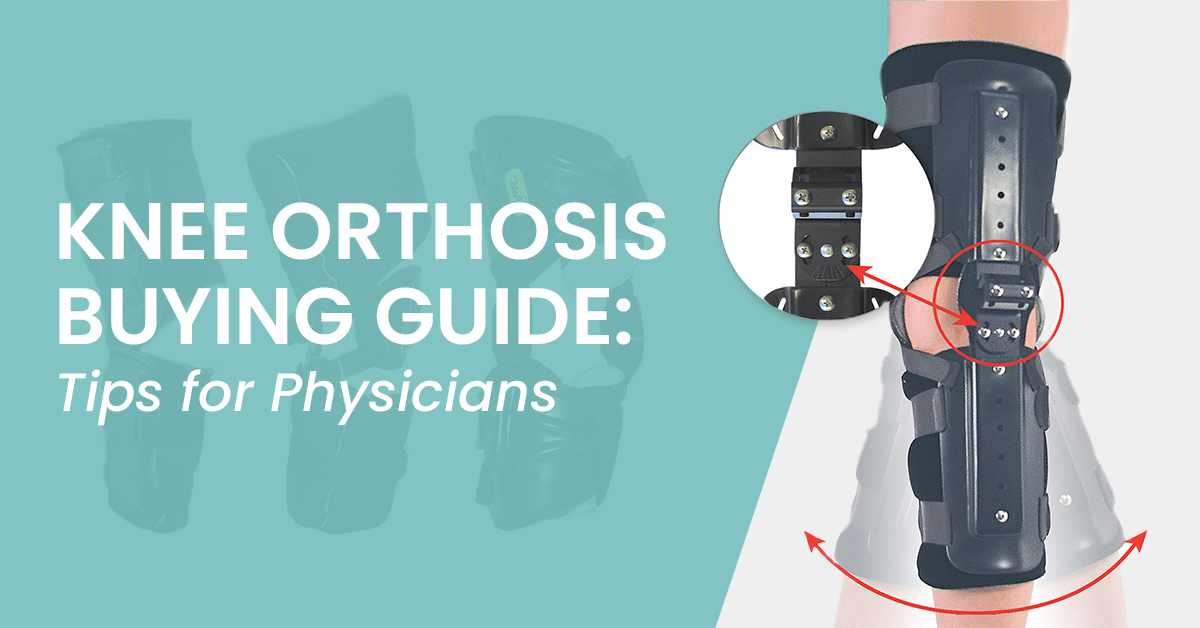
When it comes to managing knee conditions and injuries either instead of surgery or as part of recovery after surgery, physicians often rely on knee orthoses (knee braces) to provide their patients with support, stability, and pain relief. However, with various options available in the market, selecting the fitting knee orthosis can be challenging.
In this Knee Orthosis Buying Guide, we will provide physicians with 7 valuable tips to help them choose the most suitable knee orthosis for their patient's needs. We'll also note a few KO options we recommend for your patients.
Understand the Patient's Diagnosis
Before recommending a knee orthosis, it is crucial to identify the specific knee condition or injury they are experiencing, such as ligament instability, osteoarthritis, meniscal tears, or patellofemoral pain syndrome. Different orthoses are designed to address specific conditions, so knowing the diagnosis is essential for making an informed decision.Evaluate the Severity of the Condition
Assess the severity of the patient's knee condition or injury. Consider the level of instability, pain intensity, range of motion limitations, and functional restrictions they are experiencing. The severity of the condition will determine the level of support and protection required from the knee orthosis.Determine the Treatment Goals
Engage in a detailed conversation with your patient to understand their treatment goals and expectations. Discuss what they hope to achieve with the knee orthosis: pain relief, improved stability, increased mobility, or the ability to participate in specific activities or sports. Aligning their treatment goals with the features of knee orthosis will lead to better patient satisfaction and outcomes.Assess the Functional Requirements
Consider the patient's activity level and lifestyle to determine the functional requirements of the knee orthosis. Does the patient need a brace for daily activities, sports, or both? Evaluate the specific movements and stresses in their activities to identify the necessary features such as flexibility, stability, and impact absorption.
Consider the Type of Knee Orthosis
Different types of knee orthoses are available, each designed for specific purposes. Common types include prophylactic (preventive), functional, rehabilitative, unloading, and patellofemoral braces. Speak to an orthotist to familiarize yourself with the features and indications of each type to choose the one that aligns with the patient's diagnosis, treatment goals, and functional requirements.
Consider Comfort and Breathability
The patient's comfort is crucial for ensuring compliance with the knee orthosis. If the device is uncomfortable, the patient isn't likely to wear it as often as they should, which impedes recovery. Look for braces made from breathable materials that promote airflow and moisture-wicking properties to keep the skin dry. Consider cushioning or padding in areas that encounter the skin to enhance comfort and minimize irritation.Seek Expert Opinions
Consult with orthotists, physical therapists, or other healthcare professionals like ACI with expertise in orthotic devices. We provide physicians with valuable insights and recommendations based on our experience and knowledge. Collaborating with specialists ensures you make well-informed decisions and consider all relevant factors when selecting a knee orthosis for your patients.ACI Knee Orthosis Offerings
We offer a variety of Knee Orthoses to help patients manage their lower extremity ailments. Each device has the highest quality materials and is designed to produce the most positive patient outcomes. Here are a few of our KO options.
V-VAS™ Orthosis
The V-VAS™ Orthosis is a one-of-a-kind offloading/realigning brace that helps to achieve optimal varum or valgum stress without bulky or complex adjustments. Its unique polycentric adjustable hinge design creates an ideal bending moment that results in the precise offloading/realigning experience.
It is the first long-axis offloading, closed dynamic frame custom knee orthosis that doesn't need to be removed to adjust offloading, and the mechanical axis is always non-binding and auto-aligning.
KMO™(Knee Management Orthosis)
The KMO™ (Knee Management Orthosis) features a unique, single posterior joint that is cost-effective, patient-friendly, and a more accurate alternative for static progressive knee positioning.
Unlike the limited standard choice knee immobilizer, the KMO™ can more effectively position the normal anatomical alignment of the patient's knee joint, which can easily be set in position without the need to heat or contour the upright to accommodate or progressively improve knee contracture issues, specific post-op ROM (Range of Motion) positioning needs or minor fracture stabilization.
Pentagon® Orthosis
The Pentagon® Orthosis is a unique posterior fitting, single-jointed upright knee orthosis that provides another patient-friendly alternative to the traditional bulky double upright hinged knee orthoses configurations. This system design also allows for a simplified fitting of the knee orthosis that helps address many different rehabilitative needs for sagittal plane stabilization.
The Pentagon® Orthosis is the only system that allows the calf and thigh segments to dynamically shorten and lengthen with the patient's extremity during flexion and extension of the knee to accurately track the normal anatomical knee center alignment for maximum stability which also helps to reduce unwanted friction to the skin to increase patient comfort and compliance.
Make an Educated Decision
Choosing the suitable knee orthosis for your patients requires a thoughtful and informed approach. Physicians can make well-informed decisions by understanding the patient's diagnosis, assessing the severity of the condition, considering treatment goals, evaluating functional requirements, and seeking expert opinions.
Remember to prioritize comfort, adjustability, and customization options while staying within the patient's budget. With these tips, physicians can select the most appropriate knee orthosis, providing their patients with the support, stability, and relief they need for optimal recovery and improved quality of life.
 330-757-3569
330-757-3569




